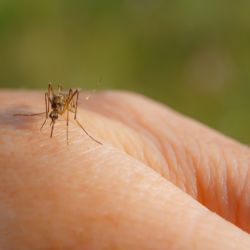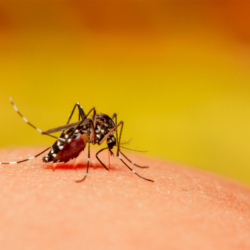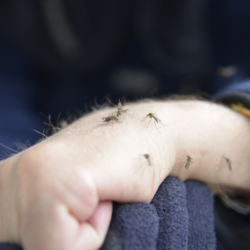Mosquitoes are much more than just a summer nuisance. In fact, they play a crucial role in the transmission of many serious diseases around the world. Because of their ability to act as vectors for various pathogens, mosquitoes are responsible for the spread of diseases such as malaria, dengue fever, chikungunya, the Zika virus and many others. Understanding the behaviour of mosquitoes, their habitats and the transmission mechanisms of the diseases they carry is essential for developing effective control and prevention strategies.
What is a mosquito?
Culicidae, more commonly known as mosquitoes, are a family of insects belonging to the order Diptera and the suborder Nematocera. They can be distinguished by their long, slender antennae and wings adorned with scales, while females have long mouthparts in the form of a rigid, biting-sucking proboscis. In 2023, there were 3,618 species of mosquito in 111 genera worldwide, although only a minority of these species attack humans.
Mosquitoes can be found on every continent except Antarctica and Iceland, colonising a variety of terrestrial environments whenever a source of fresh or brackish water, however small or temporary, is available. Their life cycle comprises four development phases: egg, larva (which goes through four larval stages), nymph and adult. The first three stages take place in water, while the final stage takes place in the air. Total development time varies from 10 to 15 days in tropical regions, depending on temperature and season.
As adults, mosquitoes are characterised by their slender bodies, long, slender legs and specialised mouthparts. Females are haematophagous, requiring blood to lay their eggs, while males feed on nectar and other sweet liquids. Adult mosquitoes have a pair of membranous wings, folded horizontally at rest, and long, slender antennae, characteristic of the Nematoceran family.
Zoom on the tiger mosquito
The tiger mosquito (Aedes albopictus or Stegomyia albopicta, depending on taxonomic classification) is a dipteran insect of the Culicidae family, native to south-east Asia. Ranked as one of the hundred most invasive species in the world, it is currently found in 100 countries on every continent.
This mosquito is characterised by a distinctive longitudinal white stripe on its black thorax. Approximately 5 mm in size, this mosquito has silver markings and its white stripe is easily identifiable to the naked eye.
The tiger mosquito thrives mainly in urban areas, where females lay their eggs on the surface of stagnant water. These eggs can survive for several months in the absence of water, which facilitates their dispersal through international trade.
An aggressive species, the tiger mosquito bites during the day, with increased activity at dawn and dusk. Once fertilised, it is the female that bites mammals or birds to obtain the blood needed to mature her eggs. Although the active flight distance of culicidae mosquitoes is generally less than 1 km, cases of passive transport by wind over several tens of km have been reported.
The species is biologically adaptable, enabling it to adapt rapidly to new environments, particularly in temperate and less humid areas. Its eggs, which are resistant to desiccation, cold and heat, also contribute to its expansion.
In mainland France, it is present in over 70 departments. The health authorities are monitoring its proliferation, and increasing public awareness of the need to reduce the number of breeding sites in order to contain its spread.
How are diseases transmitted?
Blood-sucking mosquitoes need a blood meal to lay their eggs. This process, known as the gonotrophic cycle, comprises blood sampling, egg maturation and egg laying, and is repeated several times during the mosquito’s life. The length of this cycle depends on the species, but above all on the external temperature. During the bite, the female injects anticoagulant saliva, often provoking an allergic reaction in humans. Only the females bite, after mating and fertilisation, to obtain blood as a source of nutrients for their eggs.
The female bites with her proboscis, which consists of vulcerating mouthparts. Inserting her stylets into the skin until she reaches a blood capillary, she draws blood through the maxillae that perforate the epidermis. This action makes it possible to delimit two channels: one for injecting anticoagulant saliva via the salivary channel, and the other for sucking out contaminated blood via the alimentary channel, at the level of the lip.
Reactions to the bite vary, ranging from total indolence to severe allergic reactions or even anaphylactic shock, due to hypersensitivity to antigens present in the mosquito’s saliva.
After being bitten, female mosquitoes seek out stagnant water to lay their eggs, which then hatch into larvae that develop in the water before becoming adults. Even after several months in the dry, eggs can hatch quickly when they come into contact with water. It is therefore essential to eliminate breeding sites to prevent the proliferation of mosquitoes. Mosquitoes develop more rapidly as temperatures rise.
What impact do mosquitoes have on vector-borne diseases?
Culicidae are the leading group of insects of medical and veterinary interest because of their ability to transmit disease.
As far as animals are concerned, mosquitoes, along with ticks, are the main vectors of diseases transmissible between animals, including humans. As far as humans are concerned, the mosquito is the animal responsible for the greatest number of deaths, an average of 725,000 a year. Only the females of around 80 of the 2,600 species of mosquito described take human blood, i.e. between 3% and 6%. They do so to encourage the development of their eggs.
Mosquitoes are vectors of three groups of human pathogens: Plasmodium, filaria of the genera Wuchereria and Brugia, and numerous arboviruses. More than 150 species of Culicidae have been identified as carriers of viruses implicated in human diseases. They transmit these pathogens via their proboscis.
The mosquitoes responsible for transmitting malaria, dengue fever, chikungunya, yellow fever and other diseases are mainly found in tropical regions. However, human movements and climate change favour their spread to more temperate regions, leading to the emergence of diseases that were previously absent.
What can be done to combat mosquitoes?
In France, Law no. 64-1246 of 16 December 1964 on mosquito control was initially designed to encourage the development of tourism in coastal areas. It was subsequently extended to other areas such as public health.
Larviciding, which was experimented with by the US Army during the First World War, involves using barrels of oil to prevent mosquitoes from laying eggs or breathing. However, this method proved to be ineffective on a large scale and polluted, leading to its abandonment in favour of pesticides. Large-scale chemical approaches have used larvicides since the 1950s to limit the proliferation of mosquitoes in heavily infested areas.
Large-scale non-chemical control involves modifying the environment to limit mosquito breeding sites, encourage their natural predators and avoid attracting them to inhabited areas.
Biological control techniques, such as introducing predator larvae into the wild, are also used in some regions to control mosquito populations.
At an individual level, measures to protect against mosquito bites include the use of insecticide-impregnated mosquito nets, skin repellents and long clothing.
Mosquito control also involves the management of insecticide resistance, as well as bioethical considerations concerning the impact on the environment and the need to balance the protection of human health with the preservation of biodiversity.
Finally, the idea of a planned extinction of mosquitoes is being debated because of its potential ecological implications and impact on ecosystems.





